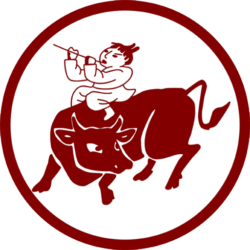by Teresa Hadland
For the European Shiatsu Congress in Kiental 2023
There is something very expressive about necks. From the gracefulness of a swan’s neck to the powerful neck of a bull. Human necks also have a wide range of differences, from long and slender to strong and condensed, and from the moment I started working with necks in humans, I became aware that I was gaining an insight into the person as a whole.
The state of a person’s neck reveals the relationship between their head and the rest of their body. When there is tension in the neck there is often a conflict between mind and body, a fight between what the mind considers possible and what the body does not. And the mind and the body are often at odds
The neck is vulnerable. It stands alone, somewhat exposed and unsupported by other structures of our skeleton. But this vulnerability could be an advantage. It means that it can be highly flexible and can act as a mediator between the head and the body. If the neck is held tense then it manifests an unsolved conflict between mind and body.
The neck is made up of a number of internal structures. These are: the larynx or voice-box; the major tubes of breathing and digestion, large arteries, veins and nerves (including the popular vagus nerve), and also, but by no means least, the thyroid gland. This quiet, unobtrusive endocrine gland situated above and behind the voice-box, produces hormones that regulate the body’s metabolic rate, growth and development. It plays a role in controlling heart, muscle and digestive function, brain development and bone maintenance. Thus, the neck is home to some very important body parts.
The Neck as a Tree Trunk

The neck is a bit like a tree trunk, with tube-shaped structures running vertically through it and supporting it from inside. The bodies of the seven cervical vertebrae, the uppermost portion of the spine, provide a strong, stable, central column, along which the tubes of digestion, blood and breathing, run parallel and anteriorly, and these are supported by muscles that allow movement. The deeper muscles run alongside the vertebrae, while the more superficial ones wrap around the tubes’ central edifice. The fascia weaves a continuous web between and around all these structures, lacing them all together. All these are contained within the skin’s most superficial layer, giving us a smooth and sensitive surface to work with.
Our head is connected through the neck to the rest of our body, and is often the part of us which is most visible to the rest of the world. As human beings we are very conscious of our fellow humans. Sometimes we can be overly conscious of how we are ‘seen’ and how we fit in with those around us. Thus, when we are feeling sad or overwhelmed, we can feel the need to put on a “brave face” to the outer world and thus hide our true state in order to avoid disapproval, embarrassment or shame. We can be afraid of “losing face” in some way. In these cases, tension in the face and especially in the jaw, spread into the neck through the connecting muscles and leads inevitably to tension or discomfort in the neck.
The lack of alignment between head and body can manifest in many different ways. People are often led in their movements by their senses, which are mostly situated in the head. Our eyes are probably the most used of our senses because, in general, we are most influenced by what we see. We notice something that catches our attention and interests us, and we are pulled towards it. It can be something that catches our eye in the shops or on the computer screen, or even something we think we need and are looking for. The stimulation from the eyes causes us to move from the eyes and head and the rest of the body is dragged along after. Sometimes the body doesn’t want to be dragged along and digs in its heels. Once again, this conflict between head and body will be felt in the neck. We can also be led in a similar way by our ears and our nose, but we tend to use these senses less than our eyes.
Our actions are led not only by our physical eyes but also by our “mind’s eye”. This can lead to our trying to be something different from our true nature. Again, this attempt to override the objections of the body leads to tensions and stress in the neck. As I said before, the neck is a bridge between the mind and body and is where the gaps in listening can be resolved. The neck tells us when we have a confrontation between our ambitions and our body.
The Neck and Emotions
Another aspect of the neck is its role in vocal expression and its link to our emotions. Our neck houses our larynx, which is built into the upper part of the trachea or windpipe. Our vocal cords (more correctly called folds) are part of the larynx and this is where the sound of our voice is made. This sound-making is closely connected with our self-expression and also our sense of self. Imagine what happens, therefore, when it is unsafe to say something. Or when we might be punished, shamed or embarrassed for speaking out. The muscles around and in the larynx contract and hold, to maintain silence. It can be quite exposing to voice something, especially if it is something challenging to others, and so we protect ourselves by not expressing and by tensing the area at the front of the neck. This, if continued over time, can lead to chronic stiffness in the throat.
A similar thing happens when we express ourselves through singing, which is a louder and even more exposing action. At some stage, many of us have been told that we “can’t sing” and have blocked off this mode of expressing ourselves by holding the muscles tight around the throat.
Expression of any kind is closely connected with emotions and we can feel how these can influence how we hold our neck. The neck is the topmost part of the spine and the spine as a whole is dramatically affected by the emotion of fear. Just as when all the hairs on the back of a cat raise up when it sees a dog, so the muscles along our spine tighten when we feel under threat. Many circumstances can produce this physiological stiffening of the neck. It doesn’t have to be a traumatic life-threatening experience, but can just as easily happen when you are stuck in traffic and are in danger of arriving late for work. If the tension remains even when the danger has passed, the stiffness can become chronic and interfere with other movements, by holding us back.
The Meridians of the Neck
All of the above shows how conflict between mind and body is embodied in structures in the neck that prevent it from flexibly mediating between them. So, helping the neck to move starts a mediation process and facilitates communication between mind and body. Bill Palmer’s research into the relationship between meridians and movement gives us clear tools for exploring the neck. The movements of the neck are strongly related to particular meridians and their function, so helping clients to explore these archetypal meridian movements gives them insight into their internal struggle. This is the main principle of Movement Shiatsu, developed by Bill in the 1980’s: to help a client to use movement to explore their habitual patterns and liberate their energy. I have been practising Movement Shiatsu for many years now and I think it provides the missing link between what the meridians are and how we express ourselves in the world through them.
In the 1980’s and 90’s, Bill worked with babies and made videos of their development. This research convincingly showed that infant movements developed progressively and followed the track of the traditional meridians. This means that meridians can be seen as the pathways along which a baby learns to inhabit and use their bodies.
In addition, babies first learn life skills through movement and then translate those movements into social and psychological capacities. He found that the skills learned through movements corresponded closely to the Qi of the meridian that guided the movement.
For instance, the movement developed along the Large Intestine meridian is a ‘pushing away’ with the arm and turning away with the head. This is first used to push against the ground to lift the head and body off the ground but later it is used to say “No” or “Enough”. This energy of pushing out / pushing away is similar to the traditional function of Large Intestine Qi, which is to expel toxic or unnecessary energy.
Over the 15 years he was doing this research, Bill found that every one of the twelve organ meridians could be explained in this way. He believes, therefore, that working with meridians is intimately connected with reminding people how to inhabit their bodies. Inner Qigong and Movement Shiatsu use these archetypal movements to help people re-embody themselves and to explore how to change habits that have cut themselves off from the innate wisdom of the body.
The neck meridians are all yang meridians and this means that the movements are all proactive, ie the body doing something in the world.
An Example: The Stomach Meridian
One of the earliest of these movements to function in the new-born baby is that of the Stomach function, and the seeking out of nourishment. In the womb, the foetus has been effortlessly provided with all its needs by the mother through the umbilical cord, and after birth the baby has to adjust very quickly to the new need of finding nourishment itself. This reaching for food is very necessary if the baby is to survive and is a strong movement in the new-born. The movement comes from the mouth, which is like a tube reaching towards the source of sustenance. By stimulating the Rooting Reflex, at this time, the baby automatically turns its head and reaches with its mouth towards the side that is being stimulated, in search of the mother’s nipple. This reflex is set into action when the skin beside the mouth is lightly stroked, and this is also the location of one of the points that lies on the Stomach meridian, Stomach 4. Thus, stroking around Stomach 4 stimulates the Stomach function and helping the baby reach with its mouth for nourishment.
The Stomach has other important lessons for the new-born. Through the drawing in of milk by sucking, the jaw, mouth and throat muscles (all parts of the body connecting closely with the upper Stomach meridian) are activated and engaged. And this in turn sets up the swallowing reflex, in the process of which, the baby opens itself up to actually receive the nourishment (ie. milk) into itself. In the act of swallowing the whole of the Stomach meridian is woken up by the resultant toning of the muscles down the length of the Stomach meridian. So, the acts of rooting, sucking and swallowing all involve specific movements in the neck relating to reaching for food nearby, to drawing it in and opening up to receive it.
Most of these reflexes happen in the first year of life; through these, the baby learns a movement and then can make the movement consciously using the same muscles. This change from unconscious reflex to conscious movement is the means by which the infant becomes embodied, and develops from a new-born, making mainly reflexive movements, to a year-old toddler who can stand and walk and express its own individuality.
These movements can be helpful to a client who finds it difficult to seek or receive support from outside. By exploring these movements in a session, the muscular patterns around the existing habit are loosened and the client can open up to being able to ask for and be comfortable with taking in support from others.

